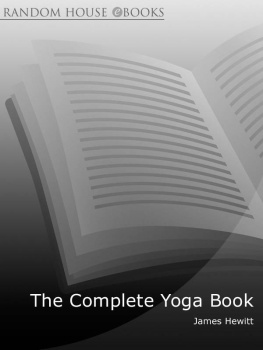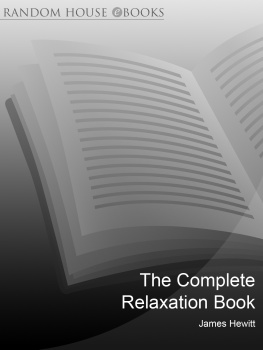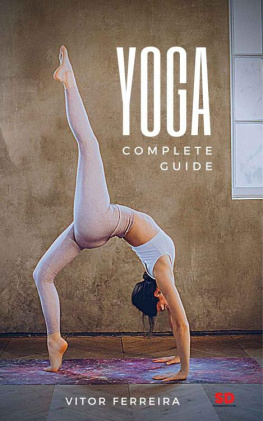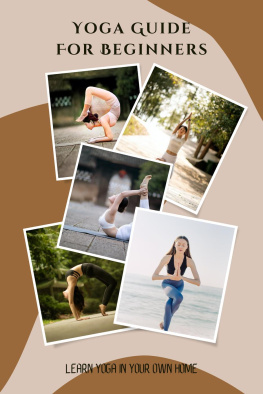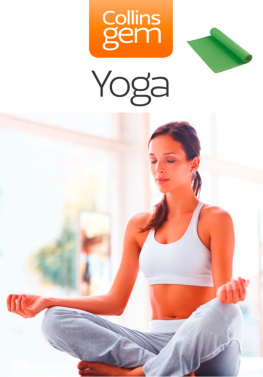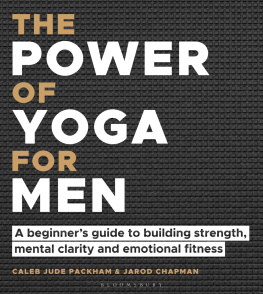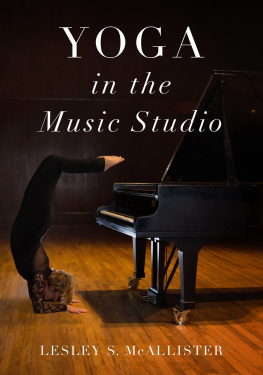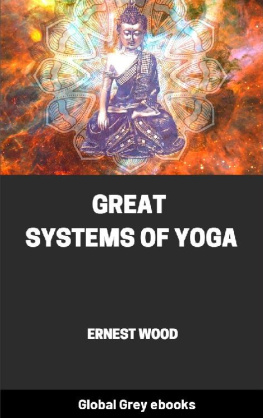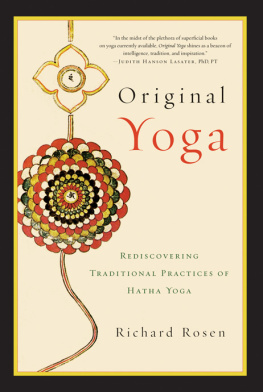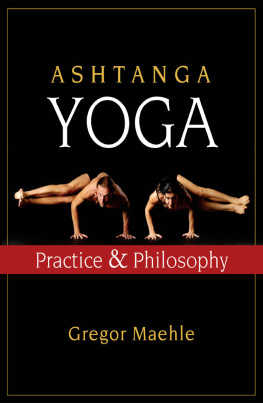James Hewitt - Complete Yoga Book
Here you can read online James Hewitt - Complete Yoga Book full text of the book (entire story) in english for free. Download pdf and epub, get meaning, cover and reviews about this ebook. year: 1990, publisher: Schocken, genre: Religion. Description of the work, (preface) as well as reviews are available. Best literature library LitArk.com created for fans of good reading and offers a wide selection of genres:
Romance novel
Science fiction
Adventure
Detective
Science
History
Home and family
Prose
Art
Politics
Computer
Non-fiction
Religion
Business
Children
Humor
Choose a favorite category and find really read worthwhile books. Enjoy immersion in the world of imagination, feel the emotions of the characters or learn something new for yourself, make an fascinating discovery.
- Book:Complete Yoga Book
- Author:
- Publisher:Schocken
- Genre:
- Year:1990
- Rating:5 / 5
- Favourites:Add to favourites
- Your mark:
- 100
- 1
- 2
- 3
- 4
- 5
Complete Yoga Book: summary, description and annotation
We offer to read an annotation, description, summary or preface (depends on what the author of the book "Complete Yoga Book" wrote himself). If you haven't found the necessary information about the book — write in the comments, we will try to find it.
Complete Yoga Book — read online for free the complete book (whole text) full work
Below is the text of the book, divided by pages. System saving the place of the last page read, allows you to conveniently read the book "Complete Yoga Book" online for free, without having to search again every time where you left off. Put a bookmark, and you can go to the page where you finished reading at any time.
Font size:
Interval:
Bookmark:
Contents
About the Book
The Complete Yoga Book is an encyclopedia of yoga practice and practical yoga as well as of the philosophy and background of yoga. It is divided into three sections.
The first of these is concerned with raising the levels of health and energy through breathing. The second section constitutes one of the most important guides ever published of the Asanas, or postures of yoga. Clear, easy to follow instructions and drawings accompany Hewitts descriptions of over 400 postures. The author includes warm-ups and many modifications of basic postures for beginners or those with specific problems. The third section deals with the history and philosophy of yoga and surveys in depth the various meditative methods including transcendental meditation. He discusses the possession of psychic powers and the potentialities of bio-feedback and relates all these developments to the classic techniques of meditation and yoga.
About the Author
James Hewitt is a former Fleet Street journalist who now writes full time. He has had thirty-five books published including; Teach Yourself Yoga, Teach Yourself Meditation (Hodder and Stoughton) and The Complete Relaxation Book (originally published as Relaxation: East and West) (Rider).
Also by James Hewitt
Teach Yourself Yoga (Hodder and Stoughton)
Teach Yourself Meditation (Hodder and Stoughton)
The Complete Relaxation Book
(originally Relaxation: East and West) (Rider)


Preface
The philosophical, metaphysical, and religious bases of Yoga may be accepted or denied, in whole or in part; but there can be no gainsaying the rewards of greater health, vitality, and psychophysical poise that result from Yoga practice, as many thousands of men and women have discovered recently in the West. In the East yoga has been practised for thousands of years. Only in this century has it been introduced into Europe and America, but it is now firmly established. It has proved to be no passing fad, simply because it fulfils its promises, supplying the results expected of it at whichever level it is practised.
It is on the practice of Yoga, and also on the practical in Yoga, that I have concentrated in writing Yoga of Breathing, and in writing two complementary works, Yoga of Posture and Yoga of Meditation. The three volumes together comprise what is virtually an encyclopedia of Yoga practice and of practical Yoga. This practical approach is aimed at enriching the health and consciousness of people going about the complicated, stress-beset activity of present-day living. Yoga has always provided for the needs of householder Yogins men and women practising Yoga without withdrawing from family life and responsibilities.
In making a practical approach to Yoga we satisfy the demands of students who consider the rewards of psycho-physical health and poise worthy aims in themselves. We also provide the aspirant who wishes for higher consciousness and mystical experience with the groundwork which equips him for the climb. The analogy with mountain climbing is apt, for the postures, breath controls, cleansing processes, and healthful eating habits and diet of physiological Yoga, called Hatha Yoga, prepare the aspirant for the subtle disciplines of psychical Yoga, called Raja Yoga. Raja Yoga refines consciousness and aims at the pinnacle of intuitive enlightenment (samadhi).
The three volumes are concerned mainly with these two Yogas, Hatha and Raja the Yogas most widely practised in the West and most easily adaptable to occidental needs.
Yoga of Breathing is intended to establish the student securely in Yogic practice; to raise levels of health, energy, and psychophysical poise, through control of breathing, posture, hygiene, relaxation, and diet. Breath control (pranayama) is at the heart of the Yoga of breathing. It has been neglected in much of the literature of Yoga for Westerners, but in this book it is given the emphasis it deserves. An example of our direct and practical approach is that the bandhas and mudras of Hatha Yoga, which are special postures and muscle controls, are employed not for prolonged breath suspension and the arousal of mysterious energies, but for the enhancement of sexual health and fitness. Yoga of Breathing also includes a balanced programme of general postures.
Yoga of Posture presents by far the largest collection of postures (asanas) ever published over 400. They include warm-up and limber-up exercises, which most Western students need before embarking on a programme of posturing; and modifications and simplifications of postures which can lead to full performance of the classic asanas. Thus there are programmes to suit any stage of suppleness.
Yoga of Meditation describes the most direct and practical techniques of meditation, including the traditional method of Patanjali, the transcendental meditation of Maharishi Mahesh Yogi, and recent Western experiments in auto-control of the involuntary nervous system using electrical biofeedback apparatus.
Each of the three volumes Yoga of Breathing, Yoga of Posture, and Yoga of Meditation stands on its own, but the three combine to make a clear and practical guide for practitioners of Yoga who wish to garner its many benefits for body and mind, and to improve the whole quality of everyday life. For Yoga is a life-science and a life-style.
Finally, a point concerning the printing of this book and of the two complementary volumes: I have followed the practice of many works written on Yoga for a mainly Western readership by omitting diacritical marks in the printing of words in Sanskrit, the classic language of Indian Yoga.
JAMES HEWITT
Volume I
Yoga of Breathing
I Yoga and Yogas
WHAT IS YOGA?
CONFUSION WILL BE avoided if we at once point out that there is Yoga as an end-goal and Yoga as a system of techniques and disciplines to reach the end-goal. Not only that: there are several systems, and therefore several Yogas. But the aim in each case is the same, though it is talked about in the language of a variety of religions and cultures. Strictly speaking, Yoga is Indian and Hindu; and for the Hindu mystic the supreme goal in living is absorption in Brahman I am that.
Who or what is Brahman? In the purest Yoga, which is that of the upanishads, Brahman is impersonal and imageless, and should not be confused with Brahma, a deity of the Hindu Trinity (the other members are Siva and Vishnu). Brahman as the One of world mysticism can be written about in a variety of ways, not all of them religious. Mysticism does not belong solely to the world religions, though it is linked closely with them. How does one classify Buddhism, which has no god, and looks on its founder, at a sophisticated level, as an enlightened man? Each age and culture finds its appropriate vocabulary for the One. In the West today, a psychological orientation makes Being, Self beyond empirical ego, and levels of consciousness the terms in which the loftiest aims of Yoga are most meaningfully discussed.
The Self to be realized beyond the ego in Indian Yoga is the Atman. Find the Atman, which is pure consciousness, through Yogic practice, and you find (the intuitive enlightenment called samadhi
Next pageFont size:
Interval:
Bookmark:
Similar books «Complete Yoga Book»
Look at similar books to Complete Yoga Book. We have selected literature similar in name and meaning in the hope of providing readers with more options to find new, interesting, not yet read works.
Discussion, reviews of the book Complete Yoga Book and just readers' own opinions. Leave your comments, write what you think about the work, its meaning or the main characters. Specify what exactly you liked and what you didn't like, and why you think so.

